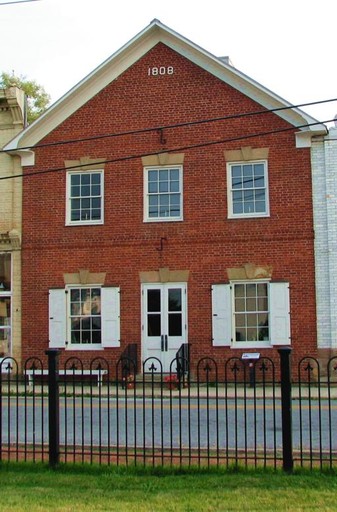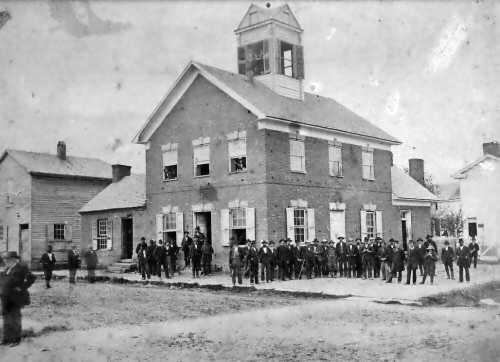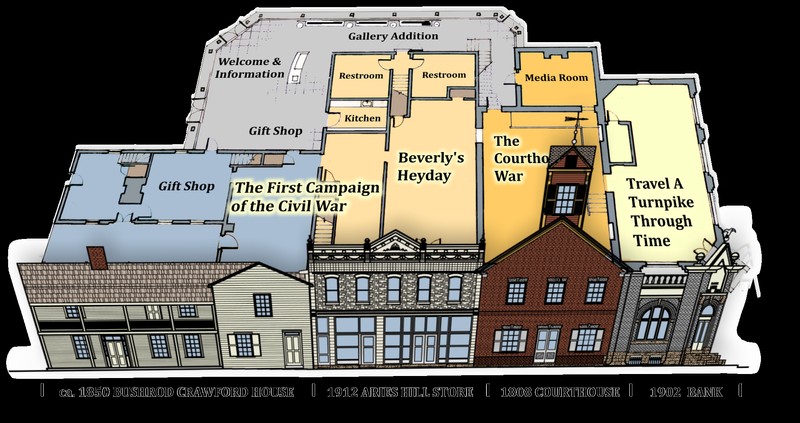Old Beverly Courthouse
Introduction
Text-to-speech Audio
Images
Modern photo of the Old Beverly Courthouse, now part of the Beverly Heritage Center. Courtesy of Historic Beverly Preservation, Inc.

Historic photo of the Old Beverly Courthouse, in use from 1815 to 1898. Courtesy of Historic Beverly Preservation, Inc.

Map of the interior of the Beverly Heritage Center, which combines the Old Beverly Courthouse with three other buildings on Court Street.

Backstory and Context
Text-to-speech Audio
Constructed at a cost of approximately $1200 in 1815 (around $16,600 now), the two-story brick structure that once served as the courthouse for Randolph County became part of the Beverly Heritage Center in 2012. From 1815 to 1894, all county court business took place at the courthouse. When West Virginia senators Henry Gassaway Davis and Stephen Benton Elkins founded the nearby town of Elkins in 1890 to service the West Virginia and Pittsburgh Central Railway and it began to outpace Beverly demographically, however, calls to move county business out of the by then outdated facilities of the Beverly courthouse quickly mounted. In an effort to keep the courthouse in their town Beverly’s residents constructed a new courthouse in 1894, but it burned down three years later.
By the end of the century, the conflict over the location of the courthouse and county seat resolved in Elkins’ favor. The building gained new life, however, as part of the new Beverly Heritage Center in the early twenty-first century. A product of cooperative efforts beginning in 2004 between Historic Beverly Preservation, the Rich Mountain Battlefield Foundation, and Staunton-Parkersburg Turnpike Alliance, the Beverly Heritage Center opened its doors in 2012 after combining the old courthouse with the adjacent Hill building, Bushrod Crawford House, and former Bank of Beverly with a rear addition. The center serves as a museum and community center dedicated to historical education and preservation in Beverly and the surrounding area.
Prior to the completion of the Old Beverly Courthouse in 1815, court sessions for Beverly and the surrounding area took place in a log structure built between 1788 and 1798. The needs of the local legal community quickly outpaced that building, however, and it remained in use for only three years after its construction. From 1803 to 1808 court sessions were held in various houses around town, including those of John Wilson and Nicholas Gibson. In 1808, Jonathan Hutton, Samuel Ball, and Matthew Whitman received appointments as a committee to contract for the construction of a more permanent home for the county’s court. Their specifications for the building were exacting: the new courthouse was to be thirty feet wide with stone floors, brick walls, and joint shingles that formed a circle at the back, the first floor was to be twelve feet high and the second eight, and there was to be a fifteen-foot square clerk’s office on the southwest corner.
When construction completed in 1815, those expectations had largely been met, and the new courthouse in Beverly stood as one of the earliest such structures built in what is now the state of West Virginia. At the time of its construction the Neoclassical architectural styles popularized by U.S. President Thomas Jefferson had largely failed to reach the western counties of Virginia and as a result the courthouse in Beverly followed the Federal style (evidenced by its plain features and absence of pilasters, or rectangular columns). Upgrades in 1826 and 1838 added a cupola at the center of the courthouse’s roof and an office for the circuit clerk, though the cupola was later removed and the clerk’s office replaced by the Hill building next door in 1907.
The construction of the Hill building not only replaced the clerk’s office but obscured a portion of the old courthouse’s façade as well, a development that in many ways reflects the changes in the structure’s fortunes in the preceding decade. Those changes came about in large part with the founding of Elkins by Senators Henry Gassaway Davis and Stephen Benton Elkins in 1890. Davis and Elkins were both prominent figures in the railroad, coal mining, and timber industries in the late nineteenth century, Davis as a self-made millionaire who began in the railroad business as a brakeman and Elkins as the husband of Davis’ daughter Hallie. The two worked together to expand Davis’ business ventures throughout the region that encompassed Randolph County and the neighboring counties of West Virginia, Virginia, and Maryland, but increasingly focused on the town of Elkins after Davis retired there from the U.S. Senate. Though they did not officially form the town until 1890, the community of Leadsville had existed at the same site for quite some time and had already begun to grow in size with their construction of the West Virginia and Pittsburgh Central Railway there in 1889. Within a few short years Elkins’ population had outpaced that of Beverly and showed little sign of slowing, a fact that translated into growing calls for the relocation of the county seat to the new town.
The conflict that arose between Elkins and Beverly over the issue reached a fever pitch late in the decade when the matter was taken into the courts and the residents of the former began to fear that it would not be resolved in their favor. Acting on that fear, they gathered weapons and marched on Beverly to physically remove the county’s court records from the Old Beverly Courthouse. Their opponents responded in kind, resulting in a tense standoff in which bloodshed was avoided only through the efforts of a group of Beverly citizens led by Dr. Humboldt Yokum that convinced the Elkins party to return home and await the decision of the court. Ultimately, that decision fell in Elkins’ favor and when the county seat moved out of Beverly the old courthouse remained as the only reminder of its town’s former status.
The history of the Old Beverly Courthouse reflects the larger narrative of its community’s progress over the course of the nineteenth century. Built in the first decades of that period during the town’s early prosperity and vacated over eighty years later as industry began to shift to other areas of the county, the courthouse serves as a window into the political and economic history of Randolph County and West Virginia more generally in the early years of their existence. The structure is also noteworthy as an early example of courthouse architecture in what was then the western portion of the state of Virginia and offers a unique opportunity to consider the Federal style’s popularity prior to the spread of Neoclassicism. While these characteristics make the building a central feature in the history of Beverly, Randolph County, and the surrounding state, however, its inclusion in the Beverly Heritage Center in the early twenty-first-century has ensured its status as an integral component of the local historical community.
Sources
"Beverly's Historic Architecture." HistoricBeverly.org. Accessed July 21, 2019. http://www.historicbeverly.org/archper.htm.
"Beverly: A More Complete History (part Three of Three)." HistoricBeverly.org. Accessed July 21, 2019. http://www.historicbeverly.org/wordpress/beverly-a-more-complete-history-part-three-of-three/.
"Beverly: A More Complete History (part Two of Three)." HistoricBeverly.org. Accessed July 21, 2019. http://www.historicbeverly.org/wordpress/beverly-a-more-complete-history-part-two-of-three/.
Bosworth, A. S. A History of Randolph County West Virginia: From Its Earliest Exploration and Settlement to the Present Time. Elkins, WV, 1898.
Carnes, Eva Margaret. "The Courthouse Wars." West Virginia Review, January 1944. Accessed July 21, 2019. http://www.wvculture.org/history/counties/courthousewars.html.
Lewis, Ronald L. Transforming the Appalachian Countryside: Railroads, Deforestation, and Social Change in West Virginia, 1880-1920. United States: University of North Carolina Press, 2000.
Maxwell, Hu. The History of Randolph County, West Virginia, from Its Earliest Settlement to the Present, Embracing Records of All the Leading Families, Reminiscences and Traditions. Morgantown, WV: Acme Publishing, 1898.
